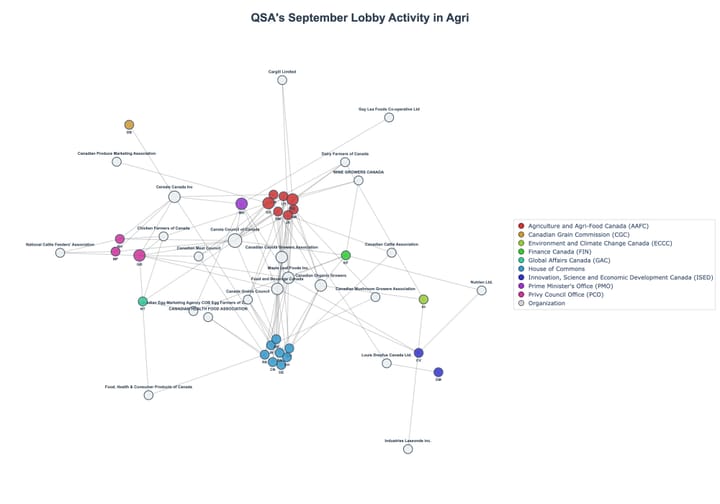QSA's Week in Agri-Food (#36, 2025)
Canada announces $4.77M agri-food research investment; FPT Ministers discuss BRM and trade; Strategic Response Fund unveiled for tariff-impacted industries; StatsCan releases crop and employment data; US revises indemnity and labor programs; BLM proposes rule rescission.

Good morning! This is Queen Street Analytics' weekly roundup of regulatory developments, legislative discussions, political announcements and other government-related news for farmers, seed-growers, fertilizers, ranchers, cattlemen and cattlewomen, as well as their upstream suppliers and downstream buyers in food manufacturing and processing. Every Monday, we break down the most important updates in this space in under five minutes.
Want to track the upstream and downstream forces affecting Agri-Food? Don’t miss this week’s updates in Freight & Ports and Oil & Gas.
Dates: 2025-09-07 to 2025-09-13
📋 In This Week's Newsletter
• 🇨🇦 Canadian Federal GR News
• 🇺🇸 US Federal GR News
• 🗺️ Canadian Provincial GR News
• 📚 What We're Reading This Week
Canadian Federal GR News
Canada and Ontario invest $4.77 million in agri-food research to address U.S. tariffs
On September 8, Agriculture and Agri-Food Canada announced up to $4.77 million for 48 research and innovation projects through the Ontario Agri-Food Research Initiative under the Sustainable Canadian Agricultural Partnership (CAP). The initiative targets Ontario’s competitiveness amid U.S. tariff uncertainty, supporting 20 companies and projects that include: piloting growing strategies for table grape safety and yield, testing probiotics against Salmonella in poultry, enhancing precision nutrient application using robotics, and developing AI tools for dairy mastitis detection. Twenty companies joined the Grow Ontario Accelerator Hub aimed at advancing commercialization. These programs will use the $3.5-billion Sustainable CAP, which combines $1 billion in federal commitments and $2.5 billion in cost-shared provincial and territorial programs.
Sources: Announcements: www.canada.ca

Federal, Provincial, Territorial Ministers focus on risk management, trade, and animal disease preparedness
From September 7 to 9, the annual FPT Ministers of Agriculture meeting convened in Winnipeg. Ministers discussed ramifications of dry conditions, wildfire activity, and recently imposed tariffs affecting Canada’s canola, peas, pork, seafood, and other commodities. Ministers reviewed upsized AgriStability compensation and maximums for 2025, and plans to add feed costs for rented pasture as allowable expenses in 2026. Interprovincial food trade, under the Safe Food for Canadians Regulations, remains a central focus, with ongoing pilots to expand slaughter availability and initiatives to modernize regulatory approval, including a centralized licensing website and streamlined pathways for feed product approvals. Animal disease issues featured, covering avian influenza, African swine fever, BSE, and Bovine Tuberculosis, and the formation of a vaccine bank for FMD. The Pest Management Regulatory Agency presented regulatory system modernization, with efforts on harmonization with U.S. BSE feed ban rules, red tape reduction, and enhanced consultation.
Sources: Announcements: www.canada.ca, Announcements: www.canada.ca
Strategic Response Fund launched to support industries impacted by U.S. tariffs, Buy Canadian policy introduced
On September 8 in Montreal, Minister Mélanie Joly announced the federal government’s $5 billion Strategic Response Fund. The fund targets Canadian sectors affected by U.S. tariffs, enabling adaptation and product diversification for impacted industries, including agri-food and seafood. Liquidity relief measures include expanded loans through the Business Development Bank of Canada and the Large Enterprise Tariff Loan Facility. The new Buy Canadian policy mandates federal purchases from domestic suppliers, extends local content requirements, and charts a path for provincial adoption. The Regional Tariff Response Initiative will dedicate $1 billion over three years to eligible SMEs, including agriculture businesses facing tariff disruption.
Sources: Announcements: www.canada.ca
Federal measures boost workforce resilience and ease Employment Insurance rules for affected sectors
On September 5, Employment and Social Development Canada rolled out new investments totaling $450 million for retraining workers displaced by tariffs and market volatility, supplementing a $120 million package allocated earlier to steel and lumber workers. The plan funds programs under the Labour Market Development Agreements with provinces and territories and includes creation of five Workforce Alliances combining industry, unions, and government for targeted labor strategies. Additional measures extend temporary EI benefits (waiver of one-week waiting period and suspension of separation payment treatment) to April 2026, and add 20 weeks of support for long-tenured workers. Job Bank modernization will use AI for job matching, application feedback, and better employer-worker connection. The Sectoral Workforce Investment Fund is slated for $382 million over five years to address acute sectoral labor shortages.
Sources: Announcements: www.canada.ca
Minister Sidhu concludes Alberta visit with focus on trade diversification and biofuels development
During a visit ending September 12, International Trade Minister Maninder Sidhu met business leaders in Edmonton and presented Canada’s trade diversification strategy to the Alberta Industrial Heartland Association conference. Sidhu promoted Canadian energy exports and foreign direct investment, referencing trade development resources such as the Trade Commissioner Service and Export Development Canada. At Imperial Oil’s new Renewable Diesel Facility, Sidhu recognized federal support for biofuels production via a $370 million incentive. The itinerary also included a visit to Edmonton International Airport’s hydrogen hub and Port Alberta Foreign Trade Zone, reflecting ongoing federal coordination of infrastructure and market access for agricultural and energy exports.
Sources: Announcements: www.canada.ca
Waivers of information requirements for living organisms and chemicals under Canadian Environmental Protection Act
The September 13 Canada Gazette, Part I, lists waivers granted for certain information requirements under the Canadian Environmental Protection Act. Cytophage Technologies Inc., Future Fields, Novozymes Canada Ltd., and others received waivers for data on the effects of living organisms on aquatic and terrestrial species, as well as antibiotic susceptibility tests. For chemicals, waivers were granted to BASF Canada Inc., Dempsey Corporation, Evonik Canada Inc., NextStar Energy Inc., and others concerning tests for mutagenicity, physical properties like density and vapour pressure, and biodegradation. These waivers may impact regulatory timelines for approval and market entry of agricultural bioproducts and inputs.
Sources: Gazette, Part I: www.gazette.gc.ca, Gazette, Part I: www.gazette.gc.ca
Ministerial conditions set for import and manufacture of new chemical substance
Canada Gazette, Part I, issued ministerial condition No. 22269 for the substance butanoic acid, 4-[[(1R)-2-[5-(2-fluoro-3-methoxyphenyl)-3-[[2-fluoro6-(trifluoromethyl)phenyl]methyl]-3,6-dihydro-4-methyl-2,6-dioxo-1(2H)-pyrimidinyl]-1-phenylethyl]amino]-, sodium salt, CAS No. 832720-36-2. Manufacture or import is permitted subject to advance notification to Environment Canada regarding manufacturing quantities, facility address, environmental release controls, and process descriptions, as well as provision of exposure and hazard data in accordance with Section 84 of the Act.
Sources: Gazette, Part I: www.gazette.gc.ca
Statistics Canada releases key crop stocks and price indices for July 2025
StatsCan’s September data show wheat, canola, and oat stocks declining as of July 31, 2025, while barley, dry peas, and lentils increased compared to the prior year. The Farm Product Price Index rose 3.7% year-over-year in June—its eighth consecutive monthly rise—driven by livestock and animal products, though crop prices lagged. Provincial monthly grain, oilseed, poultry, egg, cattle, hog, and dairy product prices for July are also now available for industry analysis.
Sources: Open Government Data Set: www.statcan.gc.ca, Open Government Data Set: www.statcan.gc.ca, Open Government Data Set: www.statcan.gc.ca
Statistics Canada updates rural employment dashboard for August 2025
StatsCan’s interactive dashboard, updated September 10, offers August reference period data and analysis on rural sector employment, providing granularity on agri-food workforce trends at the industry and regional levels.
Sources: Open Government Data Set: www.statcan.gc.ca
US Federal GR News
USDA revises approval for information collection on ruminant imports
On September 11, the Animal and Plant Health Inspection Service (APHIS) published notice of intent to revise and extend its information collection regarding the importation of sheep, goats, and other small exotic ruminants, under OMB Control Number 0579-0453. APHIS gathers exporter/importer names, origins, health statuses, and transit data to safeguard US livestock health from diseases like BSE and scrapie. The revision supports regulatory activities under Title 9, CFR parts 91, 93, 94, 95, and 96, affecting an estimated 741 respondents and 8,260 annual burden hours. Public comments are sought by November 10, 2025.
Sources: U.S. Federal Announcements: www.federalregister.gov
USDA seeks extension for avian influenza indemnity claims information collection
APHIS announced, on September 8, a request to revise and extend information collection concerning payments for avian influenza indemnity claims (OMB 0579-0440). The collection supports rapid euthanasia, cleaning, and restocking processes for poultry farms affected by both high- and low-pathogenic avian influenza, and includes relevant reporting on biosecurity and response plans. An estimated 18,999 respondents will incur 49,814 annual burden hours for required appraisals, claims, and compliance agreements. The program facilitates disease control and eligibility for federal compensation.
Sources: U.S. Federal Announcements: www.federalregister.gov
Labor Department proposes revisions to H-2A agricultural labor certification program
On September 10, the Department of Labor opened consultation on revisions to the H-2A Temporary Agricultural Labor Certification Program. The changes seek to replace existing collection tools with those used under an October 2022 final rule, retaining assurances from the April 2024 rule. The proposal would update forms ETA-9142A and ETA-790, maintaining the requirement that US employers certify no adverse effect on US workers when hiring foreign agricultural labor. The revision impacts 11,905 respondents, generating 141,472 responses and approximately 63,907 annual burden hours. Comments are open until November 10, 2025.
Sources: U.S. Federal Announcements: www.federalregister.gov
BLM proposes to rescind the Conservation and Landscape Health Rule
On September 11, the Bureau of Land Management published a proposed rule to rescind the Conservation and Landscape Health Rule (May 2024). BLM asserts that the rule, which created a policy for restoration, conservation leasing, and ACEC management, is not required under existing statutes and may limit flexibility under multiple-use and sustained-yield mandates. The proposed rescission would remove regulatory provisions for restoration and mitigation leasing and simplify the designation process for areas of critical environmental concern (ACECs). BLM estimates a reduction of 1,459 annual burden hours from discontinued information collection. Comments close November 10.
Sources: U.S. Federal Announcements: www.federalregister.gov
Domestic date assessment rate proposed for decrease in Riverside County, California
On September 12, the Agricultural Marketing Service (AMS) proposed reducing the assessment rate for dates produced or packed in Riverside County, California, from $0.15 to $0.05 per hundredweight, effective October 1, 2024 and continuing indefinitely unless modified. The California Date Administrative Committee recommends the decrease to align reserves and expenditures, projecting assessable volume will drop to 300,000 hundredweight for the 2024-2025 season. Major expenditures for management, administration, and audit amount to $89,410, to be funded through assessment revenue and reserves. AMS will consider public comments until October 14, 2025.
Sources: U.S. Federal Announcements: www.federalregister.gov
Canadian Provincial GR News
Ontario and Canada announce $4.77 million investment in agri-food research
The governments of Ontario and Canada will jointly invest up to $4.77 million to support 48 research and innovation projects and 20 companies through the Ontario Agri-Food Research Initiative.
Sources: Provincial Announcement: news.ontario.ca
BC meat inspectors classified as essential workers
BC Agriculture Minister Lana Popham confirmed provincial meat inspectors as essential workers during job action, securing safety and animal welfare support for the province’s abattoirs.
Sources: Provincial Announcement: news.gov.bc.ca
BC issues temporary water restriction orders for forage crops to protect chinook salmon
On September 8, drought-related water protection orders in the Thompson Okanagan region restrict irrigation for forage crops, impacting 490 water licences in Salmon River and Bessette Creek for salmon survival.
Sources: Provincial Announcement: news.gov.bc.ca
Manitoba proclaims Farm and Food Awareness Week
Manitoba recognizes Farm and Food Awareness Week from September 14 to 20, encouraging engagement with local producers and highlighting the province’s agricultural workforce.
Sources: Provincial Announcement: news.gov.mb.ca
Nova Scotia establishes three new collaborative food networks to improve food security
Nova Scotia announced $600,000 in one-time grants to create three new food security networks, supporting tailored community initiatives to improve reliable access to healthy food.
Sources: Provincial Announcement: news.novascotia.ca
What We're Reading This Week
- Cleanfarms Marks 15th Anniversary with White Paper on Circular Economy for Canadian Agriculture: Examines recycling and resource recovery in Canadian agriculture.
- Home-Compostable ButterFresh™ Parchment Marks New Step in ProAmpac's Sustainability Journey: Profiles a new compostable packaging solution for food applications.
- ‘There’s something strange in the pumpkin fields.’ Drought & heat frightening farmers: Reports on recent climate impacts in Canadian agriculture.
- Canadian start-up Phytokana developing new fava-based ingredients: Outlines product development in plant-based protein.
- Corn diseases lurk in bumper U.S. crop, threatening yields: Covers risk factors for upcoming US corn harvest.
- Federal government adopts new strategy to reduce animal testing: Details federal changes on animal research protocols.
- The $500M bread price-fixing class action settlement: Claims process is now open: Announces the opening of the claims process for affected consumers.
- People on Piers, Texada, southern Vancouver Island get internet connectivity: Discusses infrastructure investments in rural BC communities.
- Supporting healthy living through community-driven projects: Recaps efforts to improve food access through community gardening.
- Quebec and Canada Strong: Reviews federal actions protecting strategic industries affected by tariffs.


